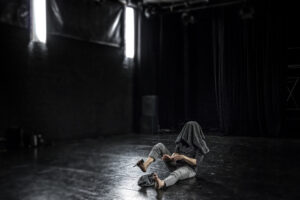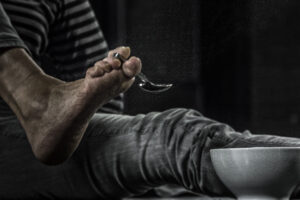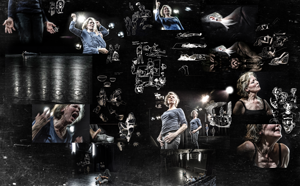Main questions of the experiment was:
“Is it possible to adapt cinematographic tools to the theatre? Is it possible to zoom in on an actor or a prop on stage?”
Why?
For the research project Rehearsal Matters, Laboratoriet interviewed 37 performing artists about their work methods and visions for their creative process. The interviews form a digital knowledge bank at www.rehearsalmatters.org. From the interviews we discovered a kind of “unrequited love” between theatre and film. Several of the theatre artists were fascinated by film as an art form and expressed a desire to use cinematographic effects on stage. This desire sparked the idea of the ZOOM experiment.

How?
The experiment took its starting point in the staging of text excerpts from the screenplay Hiroshima, My Love by Marguerite Duras, played by Bodil Lassen, and improvisations of scenes from the post-apocalyptic short story Mørkeland by Lars Kramhøft. We combined our expertise to zoom in on relevant locations, moments, body parts etc. in order to learn when, how and what we wanted to zoom and why. Both the cartoonist Lars Kramhøft and the cinematographer Erik Zappon documented the entire process.
To zoom in on stage is to control the audience’s focus on a particular movement, a line, a prop or a specific part of the body’s anatomy. How can we do that on stage?

Through dissonance in the body rhythm. The rhythms of body and language are closely intertwined. Separating the two rhythms increases the focus on individual words and their meaning.
Through accentuation of the text within the body’s physical expression. Instead of expressing the words orally, the actress uses pantomime body language to increase focus on the inner meaning of a specific word.
Through lighting effects on a specific body part. Here you see Bodil’s neck that symbolizes pulse, vulnerability and life. The sound of the pulse is created by the light.
Through highlighting an uncontrollable situation that may fail completely. Like a tightrope dancer that may fall off the rope and a dog that may bark.
Through set design or a change of perspective. If we change the audience’s perspective of the actors it automatically increases the focus on the actor as well as on the set design and the props.
By highlighting the opposite. For example, to highlight the actor’s loneliness we contrast the actor’s size in relation to the theatre space (auditorium). A light through total darkness creates a space without walls, but using a spotlight on the actor will make him/her appear small in relation to the infinite space.
By lowering the light we try to increase focus on what is not clearly visible.
Lowering the actor’s voice automatically creates focus and understanding on what is said.
By selecting a specific group among the audience who have experienced the same problem as the one portrayed on stage, we increase the responsiveness of the audience.
By acting differently from what is expected of us.
Conclusion
To zoom in on stage is not only technically impossible unless you use cinematographic techniques, it is also impossible to cut off a selected focus from authentic sounds, smells or other natural distractions. On stage we cannot control the audience’s attention as on screen. There will always be other factors that influence the focus of the audience. On the other hand this is also what makes theatre and performing arts so special – it is uncontrollable and unpredictable – as life itself.
Cast: Bodil Lassen – actress, Erik Zappon – cinematogropher, Lars Kramhøft – cartoonist, Per Mariboe and Jeppe Nissen Lighting design, technique.
ZOOM, Laboratoriet Time: May 14-17, 2013, Venue: BoraBora – dance and visual theatre

